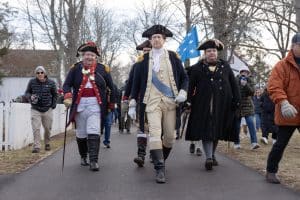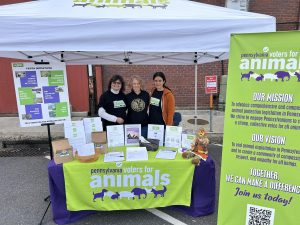Over the last few months, I have had the pleasure of becoming friends with Jen Burns through our mutual work on the Bucks County Housing Group’s Board of Directors. Beyond our shared interest in giving back to our community, I became fascinated in learning about Jen’s work on the history of Bucks County. After some conversation about approaches we could take to combat issues of hunger and housing insecurity in Bucks County, I found out that Jen had written a book – The Hidden History of Bucks County (written under her maiden name Jen Rogers). So of course, I ran over to the Doylestown Bookshop and picked up a copy. Jen’s ability to summarize an immense period of American history through the lens of Bucks County has made everyday a new learning opportunity just by stepping out of my door in Doylestown.
The following interview focuses on the contents of her book, her inspirations, as well as the process of finding and uncovering all of this information, including source documents like war journals. I would be remiss to not mention that beyond being an author, Jen is also the Communications Manager for Peddler’s Village, serves as the President of Craven Hall Historical Society, and is on the Board of Directors for the Bucks County Housing Group.
What kick started your intrigue into history and more specifically the history of Bucks County?
Bucks County boasts a history that is both unique and special, steeped in the rich tapestry of American heritage. Dating back to its founding in 1682, the county has played a pivotal role in shaping the nation’s narrative. Its stunning landscapes are filled with historic sites, from the iconic Washington Crossing Historic Park, where General George Washington and his troops crossed the Delaware River during the Revolutionary War, to the preserved colonial architecture in towns across the county. Its Quaker roots are evident in landmarks such as the Pennsbury Manor, the country estate of William Penn, the founder of Pennsylvania.
The unique blend of colonial charm and industrial progress make Bucks County a living museum of American history, drawing residents and visitors alike to explore its distinctive past and celebrate its history. I am honored to live in such a place where history isn’t necessarily confined to our textbooks but is instead woven into our community.
How did you go about researching for your book “Hidden History of Bucks County”?
While there are so many “hidden” historical spots throughout Bucks County, I had to narrow it down to fit in the book. I made a long list of all the incredible and unique historical sites, stories, and influential figures of Bucks County, then decided to weave the well-known with the unknown to create a book that both educates readers and inspires them to explore these places on their own. I visited many of these spots myself, snapped photos, and continued to research these stories in libraries and government websites. I also utilized William W. H. Davis’ book, The History of Bucks County Pennsylvania. Davis was a remarkable historian and founder of the Bucks County Historical Society.
When going through the different periods of American history that took place in Bucks County, what period was the most interesting to learn and write about?
I have always found the history of the Underground Railroad in Bucks County to be incredibly fascinating. Exploring its history is not only a riveting journey into stories of courage and resistance but also an indispensable study in understanding the local roots of the nationwide movement for emancipation. Bucks County played a pivotal role in championing human rights, particularly Quaker communities who opened their homes as safe havens for freedom seekers. The routes and hidden tunnels within historic homes amplify the local Underground Railroad’s significance in the broader struggle for human rights.
Which figures in the American Revolution Era did you find most inspiring?
Marquis de Lafayette and General Washington had immense influence in Bucks County’s history, their impact stemming from their pivotal roles in the American Revolution, collaborative efforts, and connections with the local community. Their leadership not only shaped Bucks County’s revolutionary spirit but also contributed significantly to our legacy of liberty, independence, and historical significance.
What do you think are some key takeaways from the history of Bucks County that we should remind ourselves of today?
Bucks County’s historical landmarks, such as Washington Crossing Historic Park, Underground Railroad sites, and historic homes like the Moland House and Craven Hall, emphasize the importance of preserving cultural heritage and honoring the diverse stories that contribute to a shared identity. Our history should encourage us to recognize and appreciate the lessons embedded in the struggles and triumphs of all of those who came before us.
Tell us about your experience serving in the community by working with historical societies, Craven Hall, and the Bucks County Housing Group. What motivates you to do that?
I wanted to find organizations where I could dedicate my time, skills, and resources to help foster human connections and honor our shared historical heritage. At Craven Hall, we focus on the education and preservation of our local history through free community programs. Additionally, I’m committed to helping those in need and recognize the impact that compassion and support can have on individuals and our community, which is why I wanted to get involved with the Bucks County Housing Group.
Is there a historical figure that you admire most and why?
While not an individual figure, I’m inspired by the many women who fought in the American Civil War. These women defied societal norms of their time, challenging gender roles to contribute to a cause they believed in. Their stories of dedication, disguised as male soldiers, showcase a remarkable strength of character.
Jen’s dedication to preserving the rich history of our beautiful county emanates from her writing and I encourage everyone to purchase this book, which is both a great read and makes a great gift. Order the book from Doylestown Bookshop, Farley’s Bookshop, Newtown Bookshop, Barnes & Noble, or wherever you prefer to purchase books.







